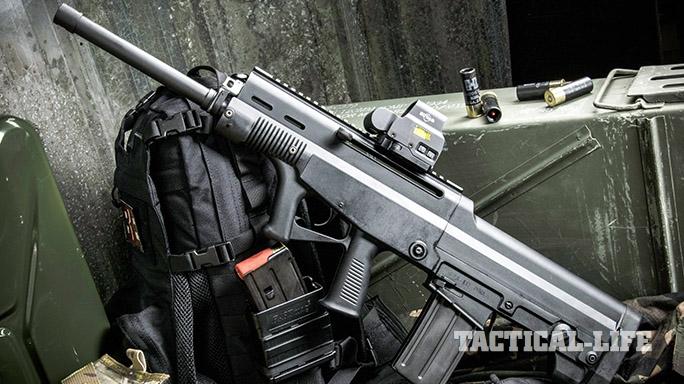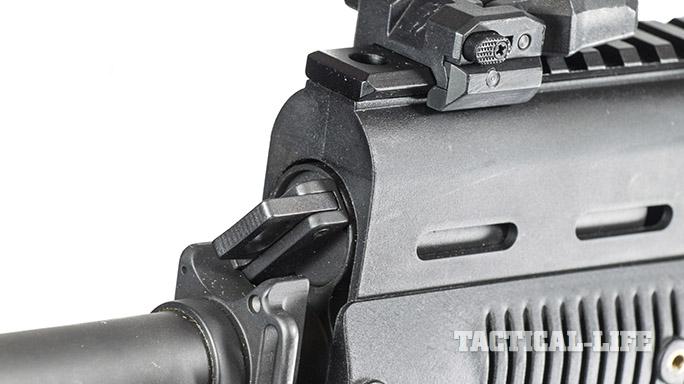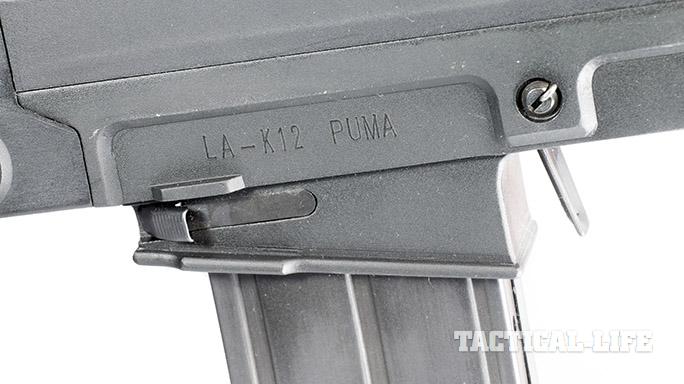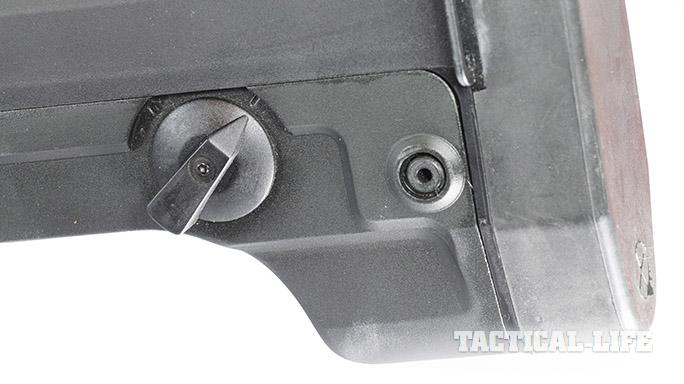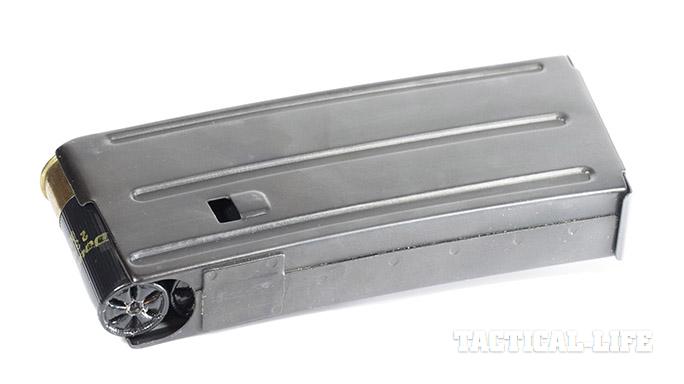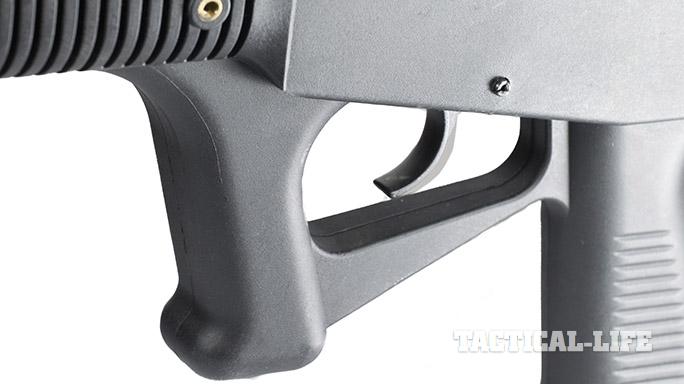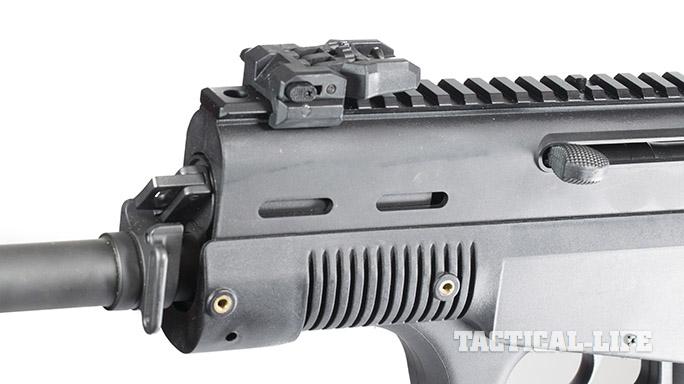The 12-gauge, pump-action shotgun is a staple of personal and home defense. It provides incredible stopping power with super-simple controls that make the manually operated scattergun a paragon of reliability.
Except, that’s not always true. Manually operated shotguns, including pump-, lever-and bolt-action designs, can malfunction if not operated forcefully enough, or too forcefully. Additionally, these same shotguns tend to be difficult for novices to reload under ideal conditions, and nigh impossible during the terrifying moments of a home invasion.
Furthermore, unless the gun has been legally registered as a short-barreled shotgun (SBS) with the BATFE and the owner is in possession of a tax stamp, they tend to be a bit too long and unwieldy to maneuver with indoors. Even those that are short enough to be handy in confined spaces are either exceptionally heavy or hold so few rounds of ammunition that the home defender might as well just use a handgun.
Advertisement — Continue Reading Below
Ideally, a home-defense shotgun should be maneuverable, reliable, easy to reload and well balanced. It should be light enough for anyone to use, but not so light that the recoil becomes unmanageable. For years, I felt this mythical “perfect shotgun” was just that—a myth—until the LA-K12 Puma was introduced.
Becoming A Reality
The LA-K12 Puma is actually a product of cooperation between the Canadian company Lever Arms and the private Kuandian Shotgun Factory in Liaoning, China. The Puma began life as a riot gun for Chinese paramilitary and riot police units. This is why the gun looks so similar to the QBZ-95 assault rifle used by the People’s Liberation Army (PLA). The designer basically scaled up the QBZ-95’s design to accommodate 12-gauge shells.
For the uninitiated, this means the LA-K12 Puma is a short-stroke-piston-driven, semi-automatic shotgun that feeds from box-type magazines. Because of the bulk of shotshells, and their tendency to rim-lock in a staggered or double-column stack, the magazines are single-stack only. This limits their capacity to five rounds. Thankfully, the Puma ships with two magazines, so an additional five rounds are only a second or two away. This is vastly quicker and easier than loading individual rounds into a magazine tube via a loading gate.
Advertisement — Continue Reading Below
The LA-K12 Puma is a bullpup shotgun, meaning its action lies behind the pistol grip. Because of this, the gun is very short—a mere 31 inches from nose to butt—despite having a 19-inch barrel. The barrel is also threaded for external Saiga-type muzzle devices. This is important because the Puma ships with a cylinder-bore barrel. Companies like SGM Tactical manufacture muzzle devices like brakes, compensators and chokes so shooters can modify the Puma’s patterning and recoil to fit their needs.
Another great feature is the adjustable gas system. Though simplistic and consisting of only two gas settings—normal and wide open—it was versatile enough to run every test round with some tweaking. So, shooters who want to load up with birdshot for competition, steel for plinking or buckshot for home defense can dial their guns in accordingly.
CQB Brawler
The LA-K12 Puma’s bullpup configuration is ideal for use in cramped spaces like vehicles or the tight corridors of houses. Because its action is located so far rearward, the barrel can begin sooner and end less than a foot past the gas system. This means the gun is very compact, but consequently, very rear-heavy. When shooters insert a fully loaded steel magazine into the gun, it becomes even more so.
Advertisement — Continue Reading Below
Unlike most magazine-fed shotguns, the Puma doesn’t utilize a forward locking tab to secure its magazines within the gun. Instead, it uses a locking latch on the left side of the magazine body. This configuration is a result of the Puma’s use of a magazine release button over a latch. Interestingly enough, this is the only gun with a push-button magazine release that would have objectively been better served with an AKM-style latch setup.
How? Well, the magazine release button is ambidextrous—which is good—but it’s also absurdly small. Think half the size of a .22 cartridge. Worse yet, it requires tremendous force to actuate, making it difficult and sometimes painful to use.
- RELATED STORY: Best Blasts – 30 New Shotguns to Get Pumped About in 2017
Additionally, it has a latch attached to the magazine well, but said latch is actually the bolt release. The logic behind this configuration eludes me, as swapping the two controls would have adhered the popular trends in bullpup ergonomics. This leads me to believe the setup is the product of either dodging litigation, or simply the adaptation of the civilian QBZ carbine’s strange push-button magazine release.
Advertisement — Continue Reading Below
Since we’re on the subject of ergonomics, the safety selector switch is located in a truly bizarre spot—the buttstock. Like the magazine release, this design quirk is a holdover from civilian QBZ carbines. It consists of a rotating dial with “safe” and “fire” settings. The selector itself is fairly easy to use, but its location means right-handed shooters will need to reach into their armpits to toggle the selector. Left-handed shooters have it even worse; they need to cant the Puma 45 degrees toward their body and reach over the gun with their support hands.
The bolt release, however, is pretty user friendly. It’s oversized and easy to hit for both left- and right-handed shooters. Furthermore, due to its proximity to the magazine well, shooters can insert a fresh mag and close the bolt on said mag in one motion.
Another positive aspect about the Puma’s ergonomics is the built-in foregrip. It’s a strange shape, but one heavily influenced (read “copied”) by the QBZ rifles in service with the PLA. It’s an interesting design, allowing the shooter to use it as either an angled foregrip or a traditional vertical grip. One oddity about the latter method: It requires the shooter keep the thumb of their support hand inside the triggerguard.
Advertisement — Continue Reading Below
Soft Shooting
The receiver shell covers more than 90 percent of the firearm. This keeps the design sleek and, more importantly, lightweight. Despite this, the LA-K12 Puma shotgun doesn’t produce as much felt recoil as most semi-automatic or pump-action shotguns. This appears to be the result of a combination of the bolt’s rearward travel being slowed by the gas system and how the gun’s layout gives the shooter mechanical advantage over the recoil impulse itself. The small foregrip in particular proved very useful for smaller shooters to better control the gun.
As for the trigger, it’s no Beretta over/under, but it’s good enough for combat or plinking use. My trigger scale measured it at around 8 pounds, with a spongy, almost early-Glock-like break. On top, the Puma has a full-length Picatinny rail for mounting optics or backup sights.
In testing, Aimpoint’s CompM4 worked well for engaging steel poppers and plate racks out to 25 yards. Beyond that, the cylinder bore tended to pattern its shot wherever it wanted.
Advertisement — Continue Reading Below
In terms of reliability, the Puma performed as it should with any shell that would fit inside its magazines. This prohibited some slightly long buckshot shells and one slug with a protruding projectile. Some of the lighter-dram rounds had trouble cycling the action with the gas setting on less flow, but it ran without issue when the dial was turned to wide open.
Overall, the LA-K12 Puma is a cool design with a few flaws. The handiness and compact nature of the design tend to overshadow its ergonomic woes, but left-handed shooters might want to steer clear. If you can learn a slightly strange manual of arms, then buyers will have one of the most compact, softest-shooting shotguns made.
LA-K12 Puma Specs
| Gauge: 12, 2¾-inch chamber |
| Barrel: 19 inches |
| OA Length: 31 inches |
| Weight: 8 pounds (empty) |
| Stock: Polymer |
| Sights: None |
| Action: Piston-operated semi-auto |
| Finish: Matte black |
| Capacity: 5+1 |
| MSRP: $899 |
LA-K12 Puma Performance
| Buckshot | Spread |
|---|---|
| Federal 9-Pellet 00 Personal Defense | 13.7 |
| Hornady 9-Pellet 00 Critical Defense | 14.3 |
| Winchester 9-Pellet 00 | 1,895 |
*Buckshot spread measured in inches at 15 yards.
Advertisement — Continue Reading Below
For more information, visit leverarms.com.
This article was originally published in “Tactical Weapons” November/December 2017. To order a copy and subscribe, visit outdoorgroupstore.com.
